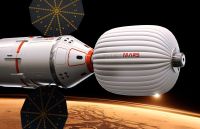To the one, it’s always worth a try ….
 Wanted: A man and a woman in their early to mid-50s, preferably married. Must enjoy adventure, spending long periods of time together, and sharing space—as in 501 days in a 1166-cubic-foot (33-cubic-meter) capsule and habitat. Interest in the planet Mars also a prerequisite.
Wanted: A man and a woman in their early to mid-50s, preferably married. Must enjoy adventure, spending long periods of time together, and sharing space—as in 501 days in a 1166-cubic-foot (33-cubic-meter) capsule and habitat. Interest in the planet Mars also a prerequisite.
Warning to applicants: You will be exposed to unprecedented risks and your long-term health could be compromised. But if the effort goes ahead and succeeds as planned, you will become the first humans in history to journey into deep space and see Mars up close.
Multimillionaire Dennis Tito, the world’s first space tourist, announced today in Washington, D.C., that his newly formed nonprofit organization has taken up the challenge of sending the first humans to Mars.
“We’ve not sent humans beyond the moon in 40 years,” Tito said at a press conference. “… And I think it’s time to put an end to that lapse.”
What’s that? A trip to Mars? With people? Marc Kaufman explains, for National Geographic News, the latest buzz in the human cosmos:
The Inspiration Mars Foundation aims to launch the mission in January 2018, when Mars and Earth are at an especially close point in their 15-year cycle. The plan is to send a man and a woman in a capsule around Mars for a flyby mission similar to the one that surveyed the moon before the Apollo landings ….
…. The Mars project is extremely ambitious, but it is at least plausible because it is simple—at least in terms of rocket science.
According to a paper Tito will present this weekend at an aerospace conference in Montana, if the launch is on target, then the spaceship will need only one rocket burn to change course. With the right trajectory, it will fly to Mars, will pass within a few hundred miles of the surface, and then will be pulled around the planet and given a gravity-assisted fling back toward Earth.
Under the current flight trajectory, the capsule would spend about ten hours within 65,000 miles of Mars.
